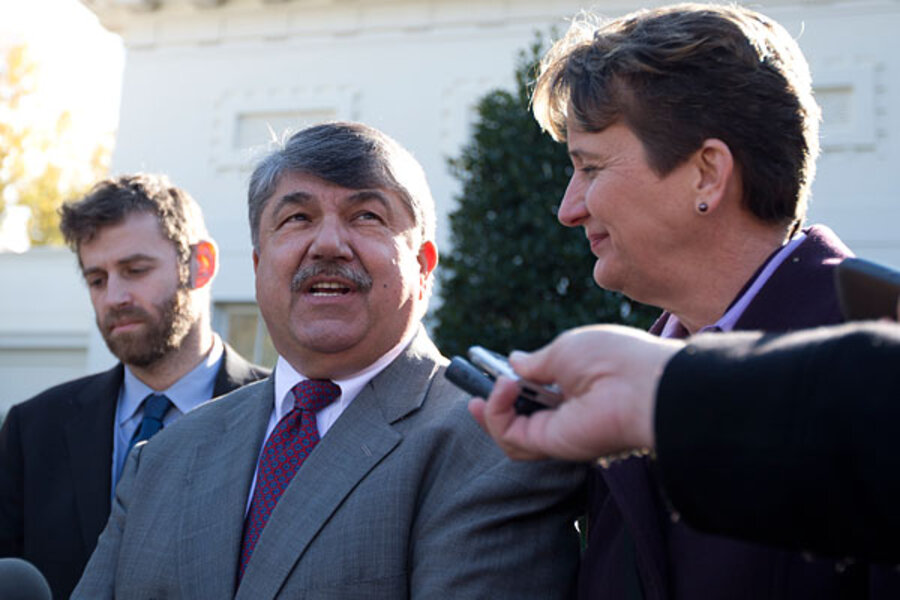Behind-the-scenes deal pushes immigration reform closer to reality
Loading...
| Washington
A compromise agreement announced Thursday between the nation’s largest labor union and the top advocate for American business underscores the enormous momentum now behind immigration reform.
The agreement touches on what was seen to be potentially one of the biggest stumbling blocks in the immigration reform debate – namely, how the country should handle the flow of low-skilled, temporary foreign workers.
In finding middle ground, the AFL-CIO and the US Chamber of Commerce – two powerful organizations often at loggerheads – have taken a “strong step forward” in resolving the issue, says Ali Noorani, executive director of the National Immigration Forum. Moreover, they have added to the impression that important stakeholders – seeing immigration reform as increasingly likely – are putting aside public posturing in order to hammer out solutions.
“This particular slice of the pie is the most important piece: What does our immigration system look like moving forward?” Mr. Noorani says. “Every day, [the Chamber and the AFL-CIO] are going to continue to put more meat on these bones.... For them to agree, even on the bones, means that they've been engaged in a really serious negotiation.”
Praise for the deal came from both sides of the aisle – House majority leader Eric Cantor (R) of Virginia and Sen. Charles Schumer (D) of New York. "We are very hopeful that an agreement can be reached on a specific proposal in the next few weeks," said Senator Schumer, a member of the bipartisan Senate group working on an immigration compromise, in a statement.
The principles of the agreement call for creating an independent commission that would study the labor market and propose tweaks to the number of lower-skilled workers admitted to the country. Currently, the number of temporary workers allowed into the country is set predominantly by quotas that continue at stable rates from year to year no matter the economic condition in the US.
The problem with the current system, all sides agree, is that it leaves worker shortages when the economy is surging and allows too many workers to enter the country when economic activity slackens. The AFL-CIO and the US Chamber of Commerce addressed this in their joint statement on Thursday.
“Our challenge is to create a mechanism that responds to the needs of business in a market-driven way, while also fully protecting the wages and working conditions of U.S. and immigrant workers,” it read.
While important details remain to be worked out, the Chamber and AFL-CIO said Thursday that the goal was achievable.
“The power of today’s technology enables us to use that knowledge to craft a workable demand-driven process fed by data that will inform how America addresses future labor shortages,” the two groups said in the statement.
Interestingly, the general concept of a commission to propose changes to visa numbers is one whose intellectual foundation lies within the labor movement. It is the brainchild of Ray Marshall, a secretary of Labor under President Carter and a co-founder of the liberal Economic Policy Institute (EPI).
But Chamber and AFL-CIO leaders, who attested to a productive working relationship during frequent meetings during the last several months, both broadly endorsed the concept Thursday.
“We recognize that there is no simple solution to this issue,” the statement says. “We agree that a professional bureau in a federal executive agency, with political independence analogous to the Bureau of Labor Statistics, should be established to inform Congress and the public about these issues.”
In 2011, the US admitted more than 2 million temporary workers, a figure that swells to more than 3 million when the workers’ families are included, according to the Department of Homeland Security. Roughly half of those, ranging from seasonal agricultural workers to nurses to electrical engineers, could be governed by a new flexible-visa regime.
But deciding which low skilled workers would have an opportunity to obtain permanent residency or, eventually, citizenship, will be a key debate. The groups also have not come to an accord on high-skilled workers.
Liberal groups were supportive of the agreement.
“We salute the notion of using real world data about labor markets and demographics to determine the future flow of employment-based immigrants and temporary foreign workers,” said Ross Eisenbrey, a vice president and economist at EPI, in an e-mailed statement. “This is an important step forward for achieving comprehensive immigration reform.”
Critics say that fine-tuning such a system is beyond the reach of any government agency.
“It is over-ambitious, but it’s more than that,” Mark Krikorian, executive director of the Center for Immigration Studies, told the Monitor earlier this month. “It’s based on an idea that we can manage government by experts. It just doesn’t work. Everybody who has tried it everywhere crashes and burns.”
The AFL-CIO and Chamber statement does not explicitly put the commission in control of visa levels, offering that such a body would be able to “advise” on such issues. The ideal system would “automatically” adjust to economic changes, according to the principles released Thursday.
“We are now in the middle – not the end – of this process,” the groups’ statement concludes, “and we pledge to continue to work together and with our allies and our representatives on Capitol Hill to finalize a solution that is in the interest of this country we all love.”







